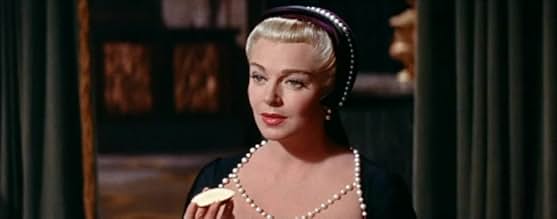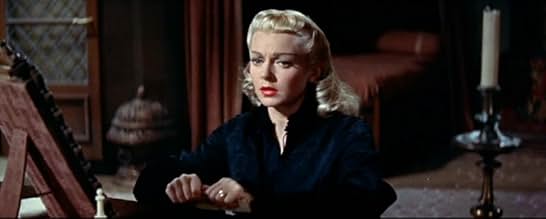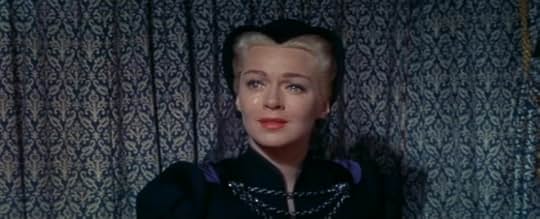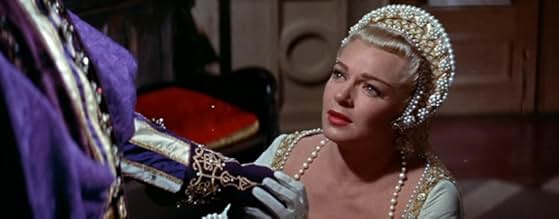Agrega una trama en tu idiomaIn the sixteenth century, a noblewoman has a love affair with the French King.In the sixteenth century, a noblewoman has a love affair with the French King.In the sixteenth century, a noblewoman has a love affair with the French King.
- Dirección
- Guionistas
- Elenco
- Dirección
- Guionistas
- Todo el elenco y el equipo
- Producción, taquilla y más en IMDbPro
Opiniones destacadas
I've said it before and I'll say it again - if a movie features actors solemnly turning away from each other to stare into the middle distance while spewing gibberish dialogue, it is more than likely a bona fide bowser.
It works in Shakespeare because actors are speaking poetry, and as long as you halfways understand what they are trying to say, it's powerful and moving. But when Hollywood hacks try it, with lines written by other Hollywood hacks, it comes across as self-important tripe.
On top of that, if instead of seasoned thespains you have pretty boys like Roger Moore, you're in trouble. Pile on the marquee with Inert Carbon Rods like Lana Turner and your move veers dangerously from bad to farce.
The low point comes about 45 minutes in when they've got some Hollywood Blvd teen staring into a crytal ball and making bold predictions. It looks like they didn't even bother rustling up a costume for the kid, just dragged him right off the stroll.
This is an epic. As in epically bad.
Lana Turner was a busy actress in the mid-Fifties, appearing in "The Sea Chase" at Warner Brothers, with John Wayne; in Twentieth-Century Fox's lavish remake of "The Rains Came," newly titled "The Rains of Ranchipur," co-starring with Richard Burton; and in her second-to-last at Metro, her long-time home studio, "The Prodigal," one of M-G-M's most expensive made-in-Hollywood spectacles. All were handsomely mounted in CinemaScope and color and all were at least moderately entertaining as well as flattering to the blonde beauty of their leading lady, "Luscious Lana." By the time "Diane" was being lensed on the Culver City soundstages in 1955, M-G-M was in straitened financial circumstances, though one would never know it by observing the deluxe production values liberally applied in the making of this costumer. One month after this picture's release in early 1956, Lana ended her eighteen year association with M-G-M and, for her, it was back to Twentieth for 1957's "Peyton Place" (and a Best Actress Oscar nomination) and thence to Universal-International where, in 1959, Lana and producer Ross Hunter began a run of some extraordinary good luck at the box office, beginning with the ultra-glossy updated remake of "Imitation of Life."
"Diane" provided Lana with a regal departure from M-G-M. All of the elements were liberally provided by M-G-M to support Lana's abilities and beauty. The property was originally planned as a Greta Garbo vehicle some years before; the eventual script was penned by Christopher Isherwood, from a story, departing from historical exactitude, as has always been Hollywood custom, by John Erskine; and visual elements were assigned to the studio's best, including costume designer Water Plunkett, who dressed Lana in a profusion of elaborate black gowns, since Diane is frequently in mourning for one noble or another as the story proceeds to the fadeout. Miklos Rozsa's score is one of his better efforts, sounding a bit less derivative of some of his earlier efforts at musically framing stories with historical settings. Additionally Lana's costars all turn in very professional work, with Marisa Pavan (the sister of the ill-fated actress Pier Angeli) especially effective as Diane's nemesis, Catherine de Medici. As an example of M-G-M's luxurious style of filmmaking, even while the studio teetered on the edge of bankruptcy, this is the kind of entertainment that is rarely reproduced in these sensation-seeking times.
The VHS version is no doubt "formatted" so, unless you are content to wait for a scheduling of this one on Turner Classic Movies, where it most likely would be letterboxed, "Caveat emptor!"
"Diane" provided Lana with a regal departure from M-G-M. All of the elements were liberally provided by M-G-M to support Lana's abilities and beauty. The property was originally planned as a Greta Garbo vehicle some years before; the eventual script was penned by Christopher Isherwood, from a story, departing from historical exactitude, as has always been Hollywood custom, by John Erskine; and visual elements were assigned to the studio's best, including costume designer Water Plunkett, who dressed Lana in a profusion of elaborate black gowns, since Diane is frequently in mourning for one noble or another as the story proceeds to the fadeout. Miklos Rozsa's score is one of his better efforts, sounding a bit less derivative of some of his earlier efforts at musically framing stories with historical settings. Additionally Lana's costars all turn in very professional work, with Marisa Pavan (the sister of the ill-fated actress Pier Angeli) especially effective as Diane's nemesis, Catherine de Medici. As an example of M-G-M's luxurious style of filmmaking, even while the studio teetered on the edge of bankruptcy, this is the kind of entertainment that is rarely reproduced in these sensation-seeking times.
The VHS version is no doubt "formatted" so, unless you are content to wait for a scheduling of this one on Turner Classic Movies, where it most likely would be letterboxed, "Caveat emptor!"
DIANE is probably the least well-known of all LANA TURNER's "big" pictures at MGM--the studio which ironically was on the verge of bankruptcy at the time of this film, but you'd never know it from the opulence of the finished work in gorgeous Technicolor and featuring one of Miklos Rozsa's more subtle scores.
It's interesting for a couple of reasons: mainly, because it appears to be a faithful recreation of that period in costumes and settings, features ROGER MOORE (youthful and handsome before his James Bond adventures), and gives LANA TURNER and MARISA PAVAN some very interesting moments as they oppose each other in a number of well played scenes.
Other than that, it's a stilted costume romance that never quite comes to life despite all the efforts to give it handsome production values. That explains its obscurity among Lana's films. The lady herself is very fetching here, beautifully costumed (mostly in black), thanks to Walter Plunkett's designs, and attractively photographed for maximum glamor effect.
But part of the unreality comes from the excessive glamor given to Turner. Despite this flaw, she does turn in a good performance as Diane de Poitiers, courtesan who stirs envy in the king's wife and is the subject of much court intrigue in medieval France.
Neglected by today's viewers who probably have never had a chance to see it, it deserves a wider audience.
It's interesting for a couple of reasons: mainly, because it appears to be a faithful recreation of that period in costumes and settings, features ROGER MOORE (youthful and handsome before his James Bond adventures), and gives LANA TURNER and MARISA PAVAN some very interesting moments as they oppose each other in a number of well played scenes.
Other than that, it's a stilted costume romance that never quite comes to life despite all the efforts to give it handsome production values. That explains its obscurity among Lana's films. The lady herself is very fetching here, beautifully costumed (mostly in black), thanks to Walter Plunkett's designs, and attractively photographed for maximum glamor effect.
But part of the unreality comes from the excessive glamor given to Turner. Despite this flaw, she does turn in a good performance as Diane de Poitiers, courtesan who stirs envy in the king's wife and is the subject of much court intrigue in medieval France.
Neglected by today's viewers who probably have never had a chance to see it, it deserves a wider audience.
An American historical drama; A story set in 16th century France. It is based loosely on the historical story about King Francis I of France who asks Diane de Poitiers, a French noblewoman and a prominent courtier, to tutor his son, Prince Henri. He becomes the future King Henri II and she becomes his mistress after his arranged marriage to Italian royal, Catherine de' Medici. The film plays out as a procession of people in elaborate, colourful costumes in grande sets and against impressive vistas. It has a stately feel, driven mainly by plot rather than excitement and moving scenes. But, at its core is an interesting tale about true love and the political maneouvering when two royal families collide. Unfortunately, it is let down by a poor script and dialogue which doesn't have enough fire bursts from its slow magma flow. The jousting scenes in the climactic royal tournament were impressive and the film is photographed well, but it feels a bit flat, even from the beginning. Lana Turner impresses though she is a little stiff in what is largely a sympathetic role. Marisa Pavan is impressive as the de Medici Queen. Roger Moore is handsome and easily copes with his character's progress from youth to kingship. The Italian noble Gondi, a villainous de Medici intermediary, is played by Henry Daniell, and is probably the most impressive performance.
The Lion company - I mean Metro Goldwyn Mayer - was excellent in terms of costume, period, historical movies: the Richard Thorpe's IVANHOE, KNIGHTS OF THE ROUND TABLE, QUENTIN DURWARD and other films such as KING'S THIEF, DIANE, SCARAMOUCHE...This somptuous historical drama has the benefits of a terrific production design, the trademark of the MGM costume movies. David Miller made this only film of this kind, unlike Richard Thorpe for hom it was a speciality, though Thorpe was a very prolific director, more than David Miller. Lana Turner is so gorgeous that she nearly makes you ignore the rest, besides her beauty. Besides, I am French and I have alwways been amazed by the fact that Hollywood was so dedicated to make films concerning history of France !!! England, yes, but France !!!! And here, Roger Moore is not at all a super but an anti hero.
¿Sabías que…?
- TriviaFollowing the huge financial failure of the film, Roger Moore was released from his seven year contract with MGM after only two years.
- ErroresEarly in the film, count Louis de Breze claims that he and Diane de Poitier had no children. Their marriage was not childless, they had two daughters, born 1515 and 1518.
- ConexionesFeatured in MGM Parade: Episode #1.16 (1955)
Selecciones populares
Inicia sesión para calificar y agrega a la lista de videos para obtener recomendaciones personalizadas
- How long is Diane?Con tecnología de Alexa
Detalles
- Fecha de lanzamiento
- País de origen
- Idioma
- También se conoce como
- Diane - Kurtisane von Frankreich
- Locaciones de filmación
- Productora
- Ver más créditos de la compañía en IMDbPro
Taquilla
- Presupuesto
- USD 2,660,000 (estimado)
- Tiempo de ejecución1 hora 50 minutos
- Relación de aspecto
- 2.55 : 1
Contribuir a esta página
Sugiere una edición o agrega el contenido que falta



































